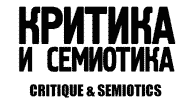Search
| # | Search | Downloads | ||||
|---|---|---|---|---|---|---|
| 1 | Video games, which create and convey meanings through complex semiotic ensembles, are one of the most multimodal media. However, the multimodal methodology per se is hardly ever used in the analysis of video games in the Russian game studies discourse. The article aims to introduce a multimodal approach to the Russian game studies discourse by presenting the key ideas and conclusions of Jason Hawreliak’s book Multimodal Semiotics and Rhetoric in Videogames. The work of the Canadian media semiotician seeks to solve two major problems: firstly, the development and explication of a theoretical approach to the semiotic definition of video games through the prism of multimodality and rhetorical analysis; secondly, the creation of a theoretical basis for a deep, sustainable dialogue between game studies and cognitive linguistics based on multimodality as a common denominator. Methodologically, Hawreliak uses an approach to multimodality based on discourse analysis and social semiotics. Structurally, Hawreliak’s monograph comprises three parts. The first part considers specific types of semiotic modalities realised in videogame media texts. Hawreliak pays special attention to the explication of procedurality as a particular semiotic mode of video games. Here the author refers to the book Hamlet on the Holodeck: The Future of Narrative in Cyberspace by Janet Murray, which adds novelty to the explication of the language of procedurality. Murray’s work still has heuristic value, containing a number of original insights about the dynamic interplay between cybertext and the process of its reading within the consolidating contour of language. Therefore, its rediscovery in the monograph by Hawreliak is important for contemporary media discourse. In addition, the Canadian media semiotician identifies the non-sensory nature of procedurality as the main factor accounting for its being underexplored within the framework of multimodal studies. The second part of the monograph investigates various modal configurations that result from combining different kinds of semiotic modes of video games. Hawreliak studies the phenomenon of multimodal consonance, i.e. the form of a special organisation of semiotic modes within a single ensemble, when they enhance each other’s influence, creating the effect of “rhetorical multiplication”. He introduces into modal consonance the element of user experience, which turns out to be a factor and the most important constituent of the “empirical rhetoric” of video games. Hawreliak expounds the mechanism of phenomenological persuasion in the video game space through the convergence of semiotic modes. The author proposes changing the traditionally negative understanding of game dissonances. He introduces the concept of “modal irony”, demonstrating how it contributes to the formation of new game options for the user through “positive tension”. In the final part of the book, the author empirically proves that video games are unstable semiotic objects. In the final chapter, which is predictive in character, Hawreliak models hypothetical scenarios of possible convergences of multimodality and promising technologies capable of creating new elements of the semiotic design of video games. In terms of style, the work strikes a good balance between comprehensibility and academic rigour. Hopefully, the consideration of multimodality in video games through the analysis of Hawreliak’s book Multimodal Semiotics and Rhetoric in Videogames will contribute to the practical convergence of game studies and multimodal studies. Keywords: video games, multimodality, Hawreliak, game studies, semiotics of video games, cybertext, semiotic modes of video games | 238 | ||||










